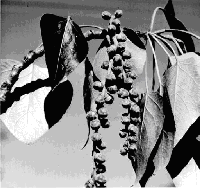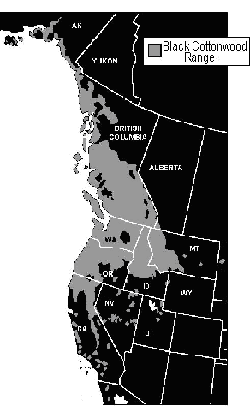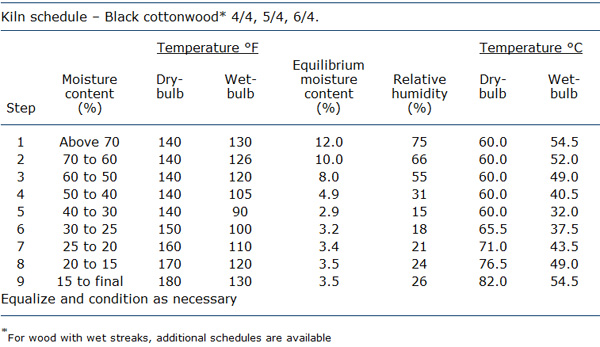
Black Cottonwood (Populus trichocarpa)
 western cottonwood, balsam poplar, balsam cottonwood, California poplar
western cottonwood, balsam poplar, balsam cottonwood, California poplar
- General Characteristics
- Biology & Management
- Harvest & Utilization
- Wood Properties
- Related Literature
- Oregon Producers and Users of Black Cottonwood
This information was originally published in Hardwoods of the Pacific Northwest, S.S. Niemiec, G.R. Ahrens, S. Willits, and D.E. Hibbs. 1995. Research Contribution 8. Oregon State University, Forest Research Laboratory
General Characteristics
 Black cottonwood is a large deciduous tree belonging to the willow family (Salicaceae). It is one of the largest of some 40 species of Populus and is the tallest, fastest-growing hardwood in the western United States. Cottonwood is a well-known, common tree along rivers and streams throughout the West.
Black cottonwood is a large deciduous tree belonging to the willow family (Salicaceae). It is one of the largest of some 40 species of Populus and is the tallest, fastest-growing hardwood in the western United States. Cottonwood is a well-known, common tree along rivers and streams throughout the West.
Cultivation of hybrid poplars (Populus trichocarpa x. P. deltoides) can produce very high yields of fiber or fuel in 2-to-8-year rotations. Refer to the publication High yield hybrid poplar plantations in the Pacific Northwest for detailed information on plantation culture.
Size, Longevity, and Form
Mature cottonwoods attain heights of 125 to 150 ft (225 ft maximum) and diameters of 48 to 60 in. (108 in. maximum). Cottonwoods mature as early as 60 years and live at least 200 years. In forest stands, cottonwoods develop narrow, cylindrical crowns and long clear boles. Open-grown trees develop deep crowns with large branches, often on single, massive stems. Natural rooting habits are not well known; planted cuttings develop deep, spreading roots.
Geographic Range
Black cottonwood grows from Kodiak Island in Alaska (lat 62°N) to northern Baja California (lat 31°N), and eastward to the Rocky Mountains in Idaho, Montana, and Canada. In the Pacific Northwest, black cottonwood is most abundant in the Puget Sound basin and in the Columbia and Willamette river basins.
Timber Inventory
The largest inventory of black cottonwood is in Washington, where it is third in total volume after red alder and bigleaf maple (Appendix 1, Table 1). Sixty percent of the total volume (456 MMCF) of black cottonwood is found in the Puget Sound subregion. Most of the remaining volume is evenly distributed between the other regions in Washington and the Northwest subregion of Oregon.
Biology and Management
Tolerance, Crown Position
Black cottonwood is intolerant of shade. It typically maintains a dominant position in the canopy via superior growth rates. In pure stands, dominance is rapidly expressed and inferior trees die out quickly. Cottonwoods commonly occur in mixed stands as scattered, emergent trees, with crowns far above associated species.
Ecological Role
Black cottonwood is a pioneer species specifically adapted to colonizing and dominating areas disturbed by floodwaters. It is generally perpetuated in such environments by recurring floods. It also colonizes disturbed upland sites with adequate moisture. Without disturbance, cottonwood is replaced by other species on upland sites.
Associated Vegetation
Several species of willow are the major associates of black cottonwood on recent alluvium along most major rivers in the Northwest. These species include Pacific, river, northwest, and Scouler willows. Other common associates are red alder, Oregon ash, bigleaf maple, Douglas-fir, western redcedar, western hemlock, Sitka spruce, grand fir, birch, cherry, and hawthorn. Common shrubs include red osier dogwood, vine maple, hazel, salmonberry, elderberry, thimbleberry, honeysuckle, spirea, and snowberry. Herbaceous associates include western swordfern, ladyfern, horsetail, stinging nettle, hedge nettle, false Solomon's-seal, Canada violet buttercup, bittercress, angelica, enchanter’s-nightshade, golden-saxifrage, and bedstraw.
Suitability and Productivity of Sites
There are no guides for estimating site productivity for black cottonwood in Oregon and Washington. The British Columbia Forest Service has identified site-quality classes for natural cottonwood. Most of the interest in the productivity of managed stands is focused on the intensive cultivation of selected clones or hybrids, in which case productivity is quite dependent on the clone under specific conditions.
Climate
Throughout its wide range, black cottonwood grows in climates that vary from humid to arid. Cottonwood thrives in the humid climate of the coastal Northwest, although it grows along rivers in arid regions as well. In its range, annual precipitation can vary from 10 to 120 in., with about one-third falling during the growing season. Much of the precipitation may fall as snow. Temperatures range from a maximum of 60 to 117°F to a minimum of -53 to 32°F. Young trees are susceptible to mortality or damage from early or late frosts. Frost cracks are common on larger trees. Stems and branches may bend or break under heavy snow or ice. Wind breakage is also common, and although their root systems are windfirm, erosion of river banks commonly topples trees.
Elevation
Black cottonwood grows from sea level to 6000 ft at the northern end of its range, to 5000 ft in the Cascade Range, and up to 7000 ft in interior mountains.
Soils
Black cottonwood grows best on deep alluvial soils with good aeration and abundant moisture. It is limited by high soil acidity, inadequate aeration, and low nutrient supplies. Although it is tolerant of winter flooding, it requires adequate drainage during the growing season. Some upland sites with deep, moist, and fertile soils are also productive for black cottonwood.
Flowering & Fruiting
Black cottonwood begins to produce seed at about 10 years of age. Male and female flowers (catkins) are borne on separate trees beginning in early March (or as late as mid-June in the north). Deciduous male catkins are 0.8 to 1.2 in. long; female catkins are 3 to 8 in. long when mature, and bear seed in capsulate fruits 0.2 to 0.32 in. long.
Seed
Black cottonwood seeds are minute, and are tufted with cottony hairs. Seed generally ripens in late May and June in the Northwest, and it is rapidly disseminated by wind and water. Viability is usually high, although it is often short-lived. Seed may remain viable for up to 1 year when dried and stored at cold temperatures.
Regeneration from Seed
Black cottonwood generally produces abundant crops of seed every year. Seedbeds must remain moist for up to 1 month for good germination and establishment. In much of the Northwest, these conditions are restricted to wet bottomlands. Cottonwood regeneration is common after logging on more upland sites in northern Washington.
Regeneration from Vegetative Sprouts
Black cottonwood sprouts readily from stumps or from buried fragments of branches. Repeated coppicing is quite successful. Regeneration also occurs from abcised shoots with green leaves, which root where they fall or are deposited by water.
Regeneration from Planting
Plantations of black cottonwood are easily established from rooted or unrooted cuttings, which allows complete control over genetic origin of stock. Successful plantings are established from unrooted cuttings of 1- to 2-year-old-wood that are 12 to 24 in. long and 0.4 to 1.2 in. in diameter. Branchwood cuttings from trees as old as 30 years have also done well. Cuttings are planted in spring to a depth of 12 to 16 in., with at least one leaf bud aboveground. Long cuttings of up to 10 ft have been used successfully in some cases; problems with inadequate rooting and poor stem form are common with long cuttings, however.
Site Preparation and Vegetative Management
Newly planted or establishing black cottonwoods are extremely sensitive to vegetative competition, particularly from grasses and herbs. Cottonwood often avoids competition from other species by establishing at high densities on new substrates and overwhelming any competing species. Complete site preparation and continued control of competing vegetation is essential for good performance in plantations. This is often accomplished with repeated mechanical cultivation and applications of herbicide.
Stand Management
Diameter growth of black cottonwood is very responsive to increased growing space. Management should target a spacing regime that produces optimal growth, while maintaining benefits of crowding in young cottonwood stands. Moderate crowding produces rapid crown closure (2 to 4 years), which suppresses competing vegetation and eliminates the need for further vegetation management treatments. For sawlog or veneer production, moderate crowding is necessary to maintain stem form, reduce branching and forking, and induce self-pruning. Typical spacings for pulpwood rotations are 6 X 6 ft to 7 X 10 ft, which accommodate tractors. Longer rotations require thinning to maintain diameter growth.
Mixed-species Stands
Black cottonwood must maintain a dominant crown position to survive and grow. To maintain other species with cottonwood, spacing and proportion of the super-dominant cottonwood must be controlled. A mixture of red alder and black cottonwood can improve the growth of cottonwood via nitrogen fixed by the red alder.
Growth and Yield
Height growth of black cottonwood often exceeds 5 ft per year for at least 10 years, and trees may reach diameters of 6 to 8 in. in that time. Various trial plantings indicate that annual yield rates from managed cottonwood can average 150 to 300 ft3 per acre for up to 24 years. Pulpwood can be grown in 10 to 15 years and sawlogs in 20 to 25 years.
Interactions with Wildlife
Because of its large size and relatively long life, black cottonwood is a superior wildlife tree in riparian areas. Fungal decay is common in wood after weather damage to tops, producing good conditions for cavity-nesting birds. Raptors such as osprey frequently nest in cottonwood. Large trees that have toppled into streams provide structure for aquatic habitat.
Animals significantly hinder establishment of black cottonwood plantations. Voles and mice cause serious losses on grassy or herbaceous sites. Beaver are often within range, and remove many trees for dams and food. Elk and deer can devastate plantings with browsing and antler rubbing. Protection or prevention of damage may be necessary to avoid severe losses.
Insects and Diseases
Many insects feed on black cottonwood, but none have caused serious problems as yet. Fungal diseases are a significant threat. Decay fungi are common; two species are noted for significant damage in British Columbia, Spongipellis delectans and Pholiota destruens. A leaf rust (Melampsora sp.) causes significant problems with clones from dry areas that are planted in western Washington. Cytospora canker (C. chrysosperma) is common in natural forests and may be a threat to regeneration from cuttings.
Genetics
Black cottonwood has outstanding potential for genetic improvement and manipulation with superior clones and hybrids. Substantial natural genetic variation within the species facilitates the development of hybrids with a variety of characteristics. Currently, the best hybrids are those between selected strains of P. trichocarpa and P. deltoides, or strains of P. maximawitzii and P. deltoides.
Harvesting and Utilization
Cruising and Harvesting
Diameter at breast height and total height can be used with tables or equations to estimate total tree volumes in cubic feet and sawlog volume. Mechanized harvesting is quite suitable for typical plantations on agricultural lands (fiber farms). Harvesting of native black cottonwood may often be subject to restrictions for the protection of riparian zones.
Logs must be manufactured and delivered very soon after trees are felled. Black cottonwood is one of the least durable species when placed in contact with the soil or exposed to the weather. Logs left in damp conditions show signs of decay within a week or two.
Product Recovery
Most cottonwood is used for pulp and paper because of its softness, light color, and ease of bleaching. Black cottonwood has been successfully sawn into lumber and peeled for veneer. Demand for black cottonwood lumber is occasionally good. Lumber and veneer are often considered to be of relatively low quality and are used primarily for cores in plywood or interior furniture parts.
Wood Properties
Characteristics
Black cottonwood is a soft, light wood of uniform texture. The sapwood is almost white, and merges into the light grey or greyish-brown heartwood, which may contain dark streaks. The wood is considered semi-ring to diffuse porous. Vessels are moderately few to very numerous; pores are numerous, small, and barely visible to the naked eye. The growth rings are inconspicuous, and are differentiated by a thin grouping of pores, which gradually increase in density at the end of the growth increment. The rays are very fine and scarcely visible with a hand lens. The wood is straight-grained and odorless and tasteless when dry. When the wood is wet, it has a characteristic disagreeable odor.
Weight
Black cottonwood weighs about 46 lb/ft3 when green and 24/ft3 at 12 percent moisture content (MC). The average specific gravity is 0.32 (green) or 0.37 (ovendry).
Mechanical Properties
Black cottonwood is a weak wood that is rarely used in applications where high strength is required. Bending strength is classed as low, while in stiffness and toughness, black cottonwood is rated as intermediate. Because of its low density, cottonwood does not readily split during nailing. The nail-holding strength of the wood is low. In bending applications, almost 70 percent of the pieces failed. Despite these apparent shortcomings, cottonwoods show some potential as framing materials because their strength properties are comparable to those of currently used softwood species of similar densities. Appendix 1, Table 3 provides information on clear strength values, as well as comparative values for similar species.
Drying and Shrinkage
The most important consideration in drying cottonwood is recognizing its extremely high MC. Heartwood MC averages 162 percent, sapwood MC averages 146 percent. The high MC, however, does not cause an unnecessarily elongated schedule. Green 4/4 lumber can be dried in 8 to 12 days, and air-dried material can be dried in 4 to 8 days. Cottonwoods have a high tendency to warp during drying because of tension wood and wet pockets. Average shrinkage from green to ovendry is 3.6 percent radially and 8.6 percent tangentially. The table below 2 provides a dry-kiln schedule appropriate for the indicated thicknesses.

Machining
Cottonwoods generally machine poorly. Surface roughness and torn grain result from planing and shaping; bore holes in cottonwood show considerable roughness and variation in size. The wood is subject to fuzzing and scratching when sanded, which contributes to problems in finishing. Tool wear and dulling is low because of the wood’s low density. Best results in planing were obtained with a hook angle of 15°.
Adhesives
Cottonwood bonds easily with adhesives of a wide range of properties and under a wide range of gluing conditions. Weak joints are sometimes created if low-viscosity adhesives are used, or if glue spread are too low. This is because cottonwood absorbs the adhesive more readily than other hardwoods.
Finishing
Cottonwood is generally painted rather than clear-coated or stained in applications that require finishes. Cottonwood’s paintability rating falls in the middle range when compared to other hardwoods. Its resistance to cupping and checking associated with outdoor exposure and weathering is very poor.
Durability
Black cottonwood is a nondurable species that will degrade rapidly if exposed to conditions favorable to decay organisms. Average service life of untreated cottonwood posts in ground contact is 4 to 5 years. Heartwood is classed as moderately difficult to penetrate with wood preservatives. The wood is moderately susceptible to sap stains and very susceptible to molds. Oxidative stains are sometimes present in cottonwood.
Uses
Cottonwood is used for veneer, pulp, pallets, interior case good parts, boxes, crates, moulding (painted), and studs.
Related Literature
BASSMAN, J.H., and J.C. ZWIER. 1993. Effect of partial defoliation on growth and carbon exchange of two clones of young Populus trichocarpa Torr. & Gray. Forest Science 39:419-431.
BOWERSOX, T.W., L.R. STOVER, C.H. STRAUSS, and P.R. BLANKENHORN. 1992. Advantages of an effective weed control program for Populus hybrids. Tree Planters Notes 43(3):81-86.
BRAATNE, J.H., T.M. HINCKLEY, and R.F. STETTLER. 1992. Influence of soil water on the physiological and morphological components of plant water balance in Populus trichocarpa, Populus deltoides and their F1 hybrids. Tree Physiology 11:325-339.
DeBELL, D.S. 1990. Black cottonwood. P. 570-576 in Silvics of North America. Volume 2, Hardwoods. R.M. Burns and B.H. Honkala, coords. USDA Forest Service, Washington D.C. Agriculture Handbook 654.
HEILMAN, P.E., R.F. STETTLER, D.P. HANLEY, and R.W. CARKNER. 1990. High yield hybrid poplar plantations in the Pacific Northwest. Washington State Cooperative Extension; Oregon State University Extension Service; University of Idaho Cooperative Extension System; USDA, [Olympia, Washington]. Pacific Northwest Bulletin PNW 356.
HEILMAN, P.E., and F.G. XIE. 1993. Influence of nitrogen on growth and productivity of short-rotation Populus trichocarpa X Populus deltoides hybrids. Canadian Journal of Forest Research 23:1863-1869.
HSIANG, T., and G.A. CHASTAGNER. 1993. Variation in Melampsora occidentalis rust on poplars in the Pacific Northwest. Canadian Journal of Plant Pathology 15:175-181.
KELLOGG, R.M., and E.P. SWAN. 1986. Physical properties of black cottonwood and balsam poplar. Canadian Journal of Forest Research 16:491-496.
McLENNAN, D.S. 1990. Spatial variation in black cottonwood (Populus trichocarpa) foliar nutrient concentrations at seven alluvial sites in coastal British Columbia. Canadian Journal of Forest Research 20:1089-1097.
ROGERS, D.L., STETTLER, R.F., and P.E. HEILMAN. 1989. Genetic variation and productivity of Populus trichocarpa and its hybrids. III. Structure and pattern of variation in a 3-year field test. Canadian Journal of Forest Research 19:372-377.
SACHSSE, H. 1975. A comparative of important wood properties of the Populus trichocarpa cultivar “Senior.” Mitteilungen. Verein fuer Forstliche Standortskunde und Forstpflanzenzuchtung 24:68
